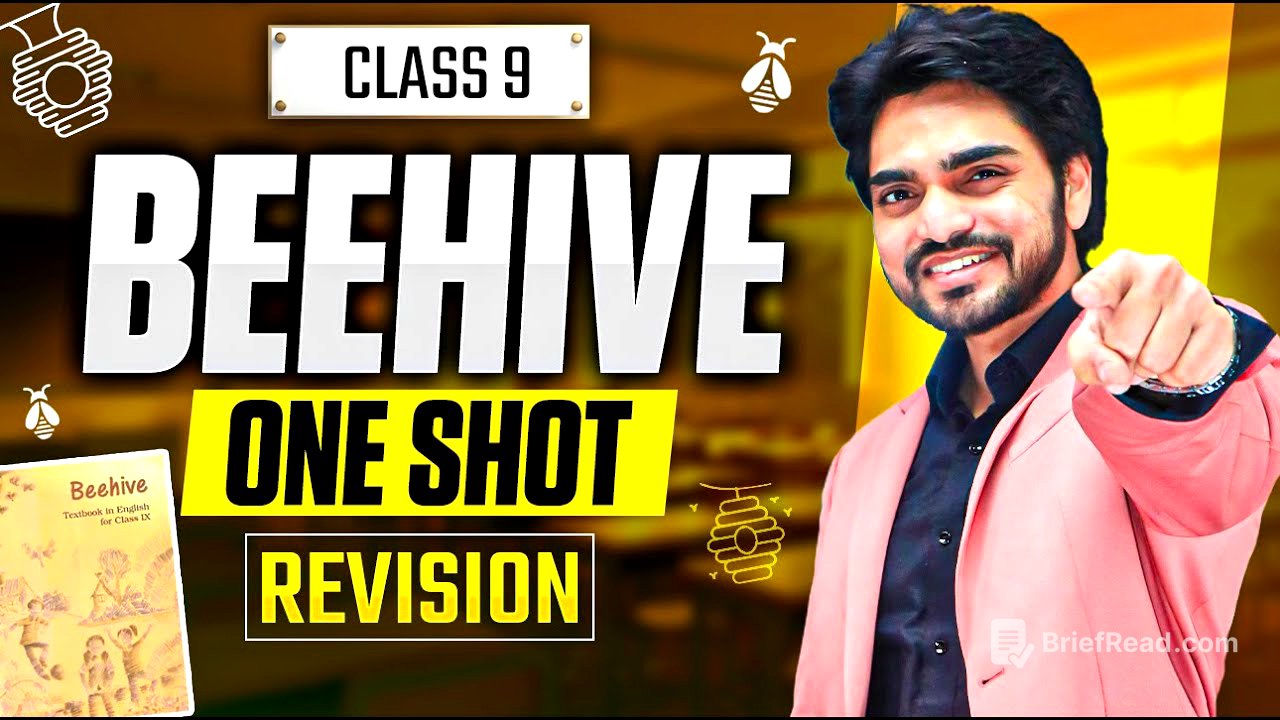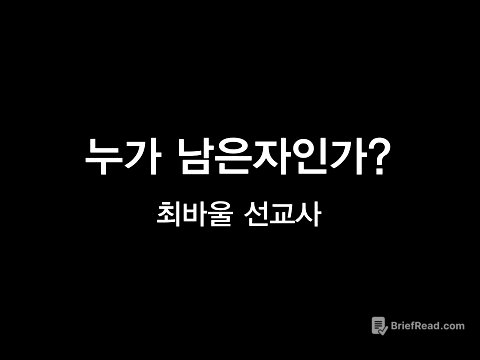TLDR;
This video provides a comprehensive shot revision of the English chapters from the Beehive textbook for class 9th students. It focuses on key points, character analysis, and potential exam questions for each chapter, aiming to simplify the learning process and alleviate students' fear of English. The video emphasizes understanding the themes and writing answers in simple sentences rather than rote memorization.
- Focus on understanding themes and characters
- Write answers in simple sentences
- Key chapters: Bismillah Khan, Albert Einstein, APJ Abdul Kalam
The Fun They Had [1:41]
The story is set in the year 2157, where children study from home using computer systems and robotic teachers. The story revolves around Margie, an 11-year-old girl, and Tommy, her 13-year-old friend, who discover an old book and learn about the traditional schools of the past. Margie expresses her dislike for her mechanical school and envies the fun that children had in the old schools with human teachers and classmates. The chapter explores the differences between mechanical and human teachers, highlighting the value of human interaction and the fun of learning in a traditional school setting. Key characters include Margie, Tommy, and the County Inspector, who fixes the mechanical teachers.
The Sound of Music - Evelyn Glennie [12:01]
This chapter tells the inspiring story of Evelyn Glennie, a deaf multi-percussionist who overcame her hearing impairment to become a world-renowned musician. Despite losing her hearing at the age of 11 due to nerve damage, Evelyn learned to feel the vibrations of sound in her body and mastered over 1,000 musical instruments. With the help of Ron Forbes, who encouraged her to feel the music rather than hear it, Evelyn gained admission to the Royal Academy of Music in London and achieved the highest marks in the academy's history. She gives free concerts for hospitals and schools and won the Soloist of the Year Award in London.
The Sound of Music - Bismillah Khan [22:17]
This section discusses Bismillah Khan, a renowned Shehnai maestro who received India's highest civilian award, the Bharat Ratna, in 2001. Born in Bihar in 1916, Bismillah Khan came from a family of musicians and performed all over the world, including at the Lincoln Center Hall in the USA. He loved Banaras and Dhamra and gave the Shehnai a classical form. During India's independence declaration in 1947, he played the Shehnai at the Red Fort in Delhi. Despite being a devout Muslim, he played the Shehnai in temples and loved the Ganga, embodying secularism and patriotism. The chapter also explains how Aurangzeb banned the Pungi, which was later improved by a barber to create the Shehnai.
The Little Girl [32:14]
The chapter revolves around Kezia, a little girl who misunderstands her strict father and is afraid of him. She perceives him as a giant and gets nervous in his presence. Her grandmother suggests she make a gift for her father, leading her to create a pin cushion filled with her father's important speech papers, which angers him. After her mother is hospitalized, Kezia has a nightmare, and her father comforts her, leading her to realize that he is a kind and loving man. The story explores the theme of a child's evolving perception of their parents and the love that lies beneath strict exteriors.
A Truly Beautiful Mind [40:57]
This chapter tells the story of Albert Einstein, one of the greatest scientists in the world. Born on March 14, 1879, Einstein was slow to speak, leading his mother to think he was crazy. His teacher called him stupid and said he would not amount to anything in life. Despite these challenges, Einstein learned to play the piano at age six and later joined a university in Zurich. He married Mileva Maric, had children, and eventually divorced. In 1915, he published his paper on the General Theory of Relativity, his biggest achievement. Einstein also wrote to US President Franklin Roosevelt about the dangers of atomic bombs and advocated for world peace and democracy. He received the Nobel Prize in Physics and is remembered not only as a scientist but also as a humanitarian.
The Snake and the Mirror [49:11]
The story is narrated by a homeopathic doctor who recounts an encounter with a snake. One hot summer night, the doctor is sitting in front of a mirror, admiring his appearance and planning to improve his looks. Suddenly, a cobra appears and wraps itself around his shoulder, its face just inches away from his. The doctor is terrified and realizes his insignificance. The snake then moves towards the mirror, and the doctor runs away. When he returns the next morning with friends, he finds that a thief has looted everything except his dirty vest, which the thief left behind.
Reach for the Top [1:10:38]
This chapter features two stories of extraordinary women. The first is Santosh Yadav, who was born in a patriarchal society in Haryana and defied societal norms to pursue her education and become a mountaineer. She resisted pressure to marry at 16 and moved to Delhi to continue her studies. Santosh joined a mountaineering group and climbed Mount Everest twice, becoming the first woman in the world to do so. She also saved a fellow climber's life by sharing her oxygen cylinder. As an environmentalist, she collected 500 kg of garbage from Mount Everest. The second story is about Maria Sharapova, a world-renowned tennis player who left her home in Russia at age nine to train in the US. She faced emotional challenges, separation from her mother, and bullying from senior players. Despite these hardships, Maria achieved the top position in the world of tennis in 2005 and remains a proud Russian.
If I Were You [1:06:47]
The chapter is a play about Gerard, a playwright, and an intruder who is a murderer on the run from the police. The intruder enters Gerard's house with a gun, intending to steal Gerard's identity to evade capture. Gerard, however, outsmarts the intruder by pretending to be a crook himself and convincing the intruder that the police are outside. He tricks the intruder into entering a cupboard, which he then locks, and calls the police to hand him over.
My Childhood [56:17]
This chapter is an excerpt from APJ Abdul Kalam's autobiography, "Wings of Fire," where he recounts his childhood. Born into a middle-class Muslim family in Rameswaram in 1931, Kalam learned honesty and self-discipline from his father and faith in goodness from his mother. He earned his first wages by distributing newspapers. Kalam had three best friends: Ramananda Shastri, Arvindam, and Shiv Prakash. He faced discrimination in school when a new teacher asked him not to sit in the front row with high-caste Brahmin boys because he was Muslim. However, his science teacher, Shiva Subramaniam Iyer, invited him to his home for a meal, defying social norms. Kalam later sought permission from his father to study at the District Headquarters in Ramanathapuram, and with his father's encouragement, he pursued his education and went on to become a great scientist and President of India.
Kathmandu [1:19:38]
Vikram Seth narrates his trip to Kathmandu, exploring the Pashupatinath and Bodhnath temples. Pashupatinath is a sacred site for Hindus with priests, tourists, pilgrims, and animals. The Bagmati River flows through it, with washerwomen cleaning clothes and children bathing. Bodhnath Temple offers a serene atmosphere with a large white dome surrounded by a Tibetan market. Kathmandu is described as a religious hub, business center, and tourist destination with bustling streets filled with sounds of radios, car horns, bicycle bells, and vendors. Vikram enjoys local treats like corn on the cob and purchases love story comics. He observes a flute seller playing different flutes, reflecting on their unique charm and the way they mimic the human voice.









